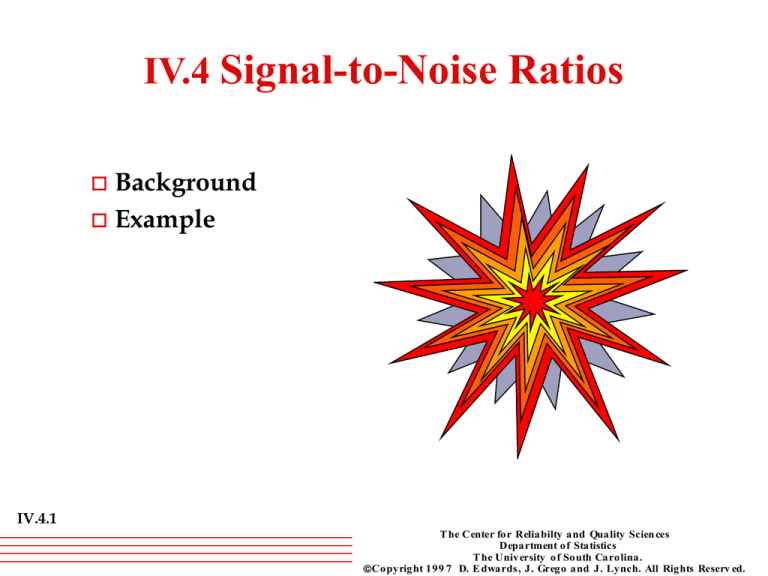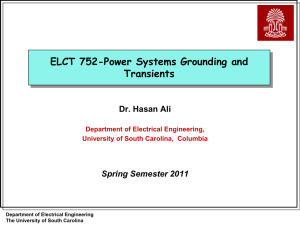
IV.4 Signal-to-Noise Ratios
Background
Example
IV.4.1
T he Center for Reliabilty and Quality Scien ces
Department of Statistics
T he University of South Carolina.
Copyright 199 7 D. E dwards , J. Grego and J. Lynch. All Rights Reserv ed.
Background
Motivation
Wouldn’t it be Nice to Have a Single
Performance Measure that Simultaneously
Identified Factor Settings that
– Optimally target the mean
– Reduce variation
This is the Major Motivation Underlying
Taguchi’s Use of Signal-to-Noise Ratios.
IV.4.2
T he Center for Reliabilty and Quality Scien ces
Department of Statistics
T he University of South Carolina.
Copyright 199 7 D. E dwards , J. Grego and J. Lynch. All Rights Reserv ed.
Background
Some Popular S/N Ratios
Taguchi proposed OVER 80 signal-to-noise (S/N) ratios.
The following three are among his most widely
applicable. Our goal is to MAXIMIZE all three.
SNs = -10 log(Sy2/n)
– What are the optimal values for yi?
– Used when “smaller is better”
SNL = -10 log(S(1/y2)/n)
– What are the optimal values for yi?
– Used when “larger is better”
SNT = 10 log(y2/s2)
– Ostensibly used when “target is better”
– How does SNT measure proximity to target?
IV.4.3
T he Center for Reliabilty and Quality Scien ces
Department of Statistics
T he University of South Carolina.
Copyright 199 7 D. E dwards , J. Grego and J. Lynch. All Rights Reserv ed.
Background
Criticisms of Taguchi’s S/N Ratios
SNs and SNL
– y will almost always be a more sensitive measure of the size
of effects on the mean
SNT
– If y and s are independent, we can look at them separately
to make better decisions
– y and s are frequently directly related, a situation SNT will
not detect
IV.4.4
T he Center for Reliabilty and Quality Scien ces
Department of Statistics
T he University of South Carolina.
Copyright 199 7 D. E dwards , J. Grego and J. Lynch. All Rights Reserv ed.
Example 6
Growing an Epitaxial Layer on Silicon Wafers
Figure 12 - Wafers Mounted on Susceptor
Kacker, R. N. and Shoemaker, A. C. (1986). “Robust Design:
A Cost-Effective Method for Improving Manufacturing
Processes” AT&T Technical Journal 65, pp.311-342.
IV.4.5
T he Center for Reliabilty and Quality Scien ces
Department of Statistics
T he University of South Carolina.
Copyright 199 7 D. E dwards , J. Grego and J. Lynch. All Rights Reserv ed.
Example 6
Growing an Epitaxial Layer on Silicon Wafers
Figure 13 - Initial and Test Settings
The response variable is thickness of epitaxial
layer in mm with a target of 14.5 mm. Which
factors will affect
– mean?
– variation?
Control
Parameter
A. Suscep tor-rotation method
B. Code of Wafers
C. Dep osition Temp erature
D. Deposition Time
E. Arsenic Flow Rate
F. Hy drochloric Acid Etch Temp erature
G. Hy drochloric Acid Flow Rate
H. Nozzle Position
Initial
Setting
Oscillating
1215oC
Low
57%
1200oC
12%
4
Test
Setting 0
Continuous
668G4
1210oC
High
55%
1180oC
10%
2
Test
Setting 1
Oscillating
678D4
1220oC
Low
59%
1215oC
14%
6
IV.4.6
T he Center for Reliabilty and Quality Scien ces
Department of Statistics
T he University of South Carolina.
Copyright 199 7 D. E dwards , J. Grego and J. Lynch. All Rights Reserv ed.
Example 6
Growing an Epitaxial Layer on Silicon Wafers
Figure 14 - The Experimental Design
IV.4.7
Each experimental run results in 70 observations
on the response!
Run
Number
1
2
3
4
5
6
7
8
9
10
11
12
13
14
15
16
A
Cont
Cont
Cont
Cont
Cont
Cont
Cont
Cont
Osclt
Osclt
Osclt
Osclt
Osclt
Osclt
Osclt
Osclt
B
668G4
668G4
668G4
668G4
678D4
678D4
678D4
678D4
668G4
668G4
668G4
668G4
678D4
678D4
678D4
678D4
C
1210
1210
1220
1220
1210
1210
1220
1220
1210
1210
1220
1220
1210
1210
1220
1220
D
High
High
Low
Low
Low
Low
High
High
Low
Low
High
High
High
High
Low
Low
E
55
59
55
59
55
59
55
59
55
59
55
59
55
59
55
59
F
1180
1215
1180
1215
1215
1180
1215
1180
1215
1180
1215
1180
1180
1215
1180
1215
G
10
14
14
10
10
14
14
10
14
10
10
14
14
10
10
14
H
2
6
6
2
6
2
2
6
2
6
6
2
6
2
2
6
T he Center for Reliabilty and Quality Scien ces
Department of Statistics
T he University of South Carolina.
Copyright 199 7 D. E dwards , J. Grego and J. Lynch. All Rights Reserv ed.
Example 6
Growing an Epitaxial Layer on Silicon Wafers
Figure 14 - The Experimental Design
Note that the design here is “non-standard”
Can you assign factors to columns A, B, C,
and D in the 16-run signs table?
– Hint: the original factors A, B, C and D cannot be used
to generate the design
Which columns would the other 4 factors be
assigned to in the 16-run signs table?
IV.4.8
T he Center for Reliabilty and Quality Scien ces
Department of Statistics
T he University of South Carolina.
Copyright 199 7 D. E dwards , J. Grego and J. Lynch. All Rights Reserv ed.
Example 6 - Analysis Using Only SNT
Growing an Epitaxial Layer on Silicon Wafers
Figure 16a - Completed Response Table
y
1
2
3
4
5
6
7
8
9
10
11
12
13
14
15
16
IV.4.9
Sum
Divisor
Effect
A
B
C
D
SN(T) A
B
C
E
27.84
26.37
37.25
29.6
37.25
27.8
26.65
24.05
35.45
31.5
27.8
25.77
29.35
26.31
29.75
31.49
474.23
16
29.639
-1
1
-1
1
-1
1
-1
1
-1
1
-1
1
-1
1
-1
1
-28.45
8
-3.556
-1
-1
1
1
-1
-1
1
1
-1
-1
1
1
-1
-1
1
1
-9.51
8
-1.189
AB
AC
AD
-1
-1
1
1
1
-1
-1
-1
-1
-1
-1
-1
-1
1
1
-1
-1
1
-1
-1
1
-1
1
-1
1
1
-1
-1
1
-1
1
-1
-1
-1
1
1
-1
1
1
-1
-1
1
1
1
-1
-1
1
-1
-1
1
-1
1
-1
1
-1
-1
1
1
-1
1
1
1
1
-1
-1
1
1
-1
1
1
1
1
-1
-1
-1
1
1
1
1
1
-8.93
0.61
7.37
1.75
13.89
8
8
8
8
8
-1.116 0.0763 0.9213 0.2188 1.7363
BC
1
1
-1
-1
-1
-1
1
1
1
1
-1
-1
-1
-1
1
1
-8.03
8
-1.004
BD
1
1
-1
-1
1
1
-1
-1
-1
-1
1
1
-1
-1
1
1
-6.09
8
-0.761
T he Center for Reliabilty and Quality Scien ces
Department of Statistics
T he University of South Carolina.
Copyright 199 7 D. E dwards , J. Grego and J. Lynch. All Rights Reserv ed.
Example 6 - Analysis Using Only SNT
Growing an Epitaxial Layer on Silicon Wafers
Figure 17 - Effects Normal Probability Plot
IV.4.10
T he Center for Reliabilty and Quality Scien ces
Department of Statistics
T he University of South Carolina.
Copyright 199 7 D. E dwards , J. Grego and J. Lynch. All Rights Reserv ed.
Example 6 - Analysis Using Only SNT
Growing an Epitaxial Layer on Silicon Wafers
Interpretation
What factors favorable affect SNT?
– A (susceptor rotation method) set at continuous
– H (nozzle position) set at 6.
IV.4.11
T he Center for Reliabilty and Quality Scien ces
Department of Statistics
T he University of South Carolina.
Copyright 199 7 D. E dwards , J. Grego and J. Lynch. All Rights Reserv ed.
Example 6 Analysis Using Mean and Log(s)
Growing an Epitaxial Layer on Silicon Wafers
Figure 18a - Response Table for Mean
y
1
2
3
4
5
6
7
8
9
10
11
12
13
14
15
16
Sum
Divisor
A
B
C
D
Mean A
B
C
E
14.82
13.97
14.16
14.88
14.1
14.84
14.76
13.91
14.89
14.03
13.86
14.93
13.88
14.42
14.92
13.91
230.28
16
-1
1
-1
1
-1
1
-1
1
-1
1
-1
1
-1
1
-1
1
-0.5
8
-1
-1
1
1
-1
-1
1
1
-1
-1
1
1
-1
-1
1
1
0.38
8
-1
-1
-1
-1
1
1
1
1
-1
-1
-1
-1
1
1
1
1
-0.8
8
AB
-1
-1
-1
-1
-1
-1
-1
-1
1
1
1
1
1
1
1
1
-0.6
8
AC
1
-1
-1
1
1
-1
-1
1
1
-1
-1
1
1
-1
-1
1
0.36
8
1
-1
1
-1
-1
1
-1
1
1
-1
1
-1
-1
1
-1
1
-0.66
8
AD
1
-1
1
-1
1
-1
1
-1
-1
1
-1
1
-1
1
-1
1
-0.02
8
BC
BD
1
1
-1
-1
-1
-1
1
1
1
1
-1
-1
-1
-1
1
1
0.14
8
1
1
-1
-1
1
1
-1
-1
-1
-1
1
1
-1
-1
1
1
0.42
8
IV.4.12
T he Center for Reliabilty and Quality Scien ces
Department of Statistics
T he University of South Carolina.
Copyright 199 7 D. E dwards , J. Grego and J. Lynch. All Rights Reserv ed.
Example 6 Analysis Using Mean and Log(s)
Growing an Epitaxial Layer on Silicon Wafers
Figure 19a - Response Table for Log(s)
1
2
3
4
5
6
7
8
9
10
11
12
13
14
15
16
IV.4.13
Sum
Divisor
Effect
y
A
B
C
D
Log(s)
A
B
C
E
-0.2213
-1
-1
-1
-0.1734
1
-1
-1
-0.7115
-1
1
-1
-0.3077
1
1
-1
-0.7154
-1
-1
1
-0.2185
1
-1
1
-0.1634
-1
1
1
-0.0595
1
1
1
-0.5995
-1
-1
-1
-0.4282
1
-1
-1
-0.2485
-1
1
-1
-0.1146
1
1
-1
-0.3253
-1
-1
1
-0.1566
1
-1
1
-0.3135
-1
1
1
-0.4313
1
1
1
-5.1882 1.4086 0.4882 0.4212
16
8
8
8
-0.32426 0.1761
0.061 0.0527
AB
-1
-1
-1
-1
-1
-1
-1
-1
1
1
1
1
1
1
1
1
-0.047
8
-0.006
1
-1
-1
1
1
-1
-1
1
1
-1
-1
1
1
-1
-1
1
-0.361
8
-0.045
AC
1
-1
1
-1
-1
1
-1
1
1
-1
1
-1
-1
1
-1
1
-0.105
8
-0.013
AD
1
-1
1
-1
1
-1
1
-1
-1
1
-1
1
-1
1
-1
1
-0.696
8
-0.087
T he Center for Reliabilty and Quality Scien ces
Department of Statistics
T he University of South Carolina.
Copyright 199 7 D. E dwards , J. Grego and J. Lynch. All Rights Reserv ed.
Example 6 Analysis Using Mean and Log(s)
Growing an Epitaxial Layer on Silicon Wafers
Figure 20 - Effects Normal Probability Plot for Mean
IV.4.14
T he Center for Reliabilty and Quality Scien ces
Department of Statistics
T he University of South Carolina.
Copyright 199 7 D. E dwards , J. Grego and J. Lynch. All Rights Reserv ed.
Example 6 Analysis Using Mean and Log(s)
Growing an Epitaxial Layer on Silicon Wafers
Figure 21 - Effects Normal Probability Plot for Log(s)
IV.4.15
T he Center for Reliabilty and Quality Scien ces
Department of Statistics
T he University of South Carolina.
Copyright 199 7 D. E dwards , J. Grego and J. Lynch. All Rights Reserv ed.
Example 6 Analysis Using Mean and Log(s)
Growing an Epitaxial Layer on Silicon Wafers
Interpretation
What factors affect the mean?
– D (deposition time) set at high level increases the mean.
What factor settings favorably affect
variability?
– A (susceptor rotation method) set at continuous.
– H (nozzle position) set at 6.
– D (deposition time) set at low.
IV.4.16
T he Center for Reliabilty and Quality Scien ces
Department of Statistics
T he University of South Carolina.
Copyright 199 7 D. E dwards , J. Grego and J. Lynch. All Rights Reserv ed.
Example 6 Analysis Using Mean and Log(s)
Growing an Epitaxial Layer on Silicon Wafers
Interpretation
Conclusions:
– Set nozzle position at 6
– Use continuous susceptor rotation method
– Use deposition time to adjust mean to target
IV.4.17
T he Center for Reliabilty and Quality Scien ces
Department of Statistics
T he University of South Carolina.
Copyright 199 7 D. E dwards , J. Grego and J. Lynch. All Rights Reserv ed.






